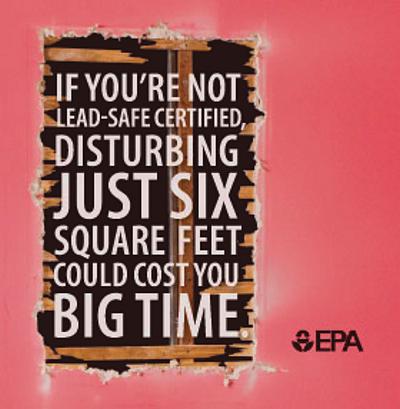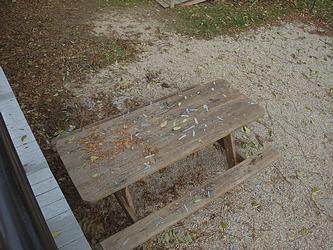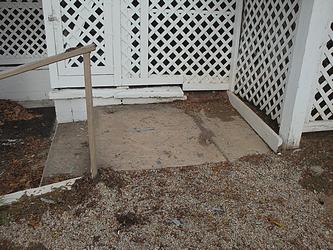EPA Publishes First RRP Enforcement of Lead Safe Work Practices
Today the EPA announced it's first enforcement actions against a renovator for violations of the lead-safe work practices required under the RRP Rule.
 The press release below explains how the violator was investigated after a YouTube video of the the renovator's workers in action was posted showing the total lack of lead-safe work practices in place as the workers used power equipment to remove paint on a rental property on Rockland ME.
The press release below explains how the violator was investigated after a YouTube video of the the renovator's workers in action was posted showing the total lack of lead-safe work practices in place as the workers used power equipment to remove paint on a rental property on Rockland ME.
EPA’s investigation found that Mr. Wentworth failed to: obtain required certification as a renovation firm from EPA; post warning signs in the work area; cover the ground in the work area with plastic sheeting to collect falling lead paint debris; contain waste from the renovation activities to prevent releases of dust and debris before the waste is removed from the work area for storage or disposal; prohibit use of machines that remove lead-based paint through high speed operation without HEPA exhaust controls; and establish and maintain records necessary to demonstrate compliance with the Renovation Rule.
Click here to watch the video which provided all the evidence the EPA needed.
 Will this be the first of many press releases by EPA regarding enforcement? Many contractors who have complied with the RRP rule hope so. According to Curt Spalding, regional administrator of EPA’s New England office: "Enforcement of these rules is important to protecting children and the business interests of those contractors who are following the rules.”
Will this be the first of many press releases by EPA regarding enforcement? Many contractors who have complied with the RRP rule hope so. According to Curt Spalding, regional administrator of EPA’s New England office: "Enforcement of these rules is important to protecting children and the business interests of those contractors who are following the rules.”
Time will tell if anyone else at EPA other Curt Spalding recognizes the importance of enforcement.

News Release
U.S. Environmental Protection Agency
New England Regional Office
May 16, 2011
Contact: David Deegan, (617) 918-1017
Maine Renovator Faces Penalty for Violations of Lead Renovation Rule
(Boston, Mass. – May 16, 2011) – A Rockland, Maine renovator is facing penalties for allegedly violating requirements designed to protect children from exposure to lead-based paint during painting and other renovation activities.
According to information gathered by inspectors from the Maine Department of Environmental Protection, the U.S. Department of Labor’s Occupational Safety and Health Administration and EPA, two workers employed by Colin Wentworth of Rockland failed to contain dust and debris generated by lead paint removal activities during a repainting project in October 2010. Although Mr. Wentworth had completed the eight-hour course required by the Lead Renovation, Repair and Painting (RRP) Rule, he did not provide the required training or supervision to his employees to ensure that they followed the required work practices prior to their use of high-speed dust-generating power tools to remove lead paint from the building. Mr. Wentworth also failed to take steps to obtain the mandatory lead-safe certification for his firm.
The violations were brought to EPA’s attention via an anonymous tip linking to a video of the violations, posted on YouTube and taken in October 2010. The video documented workers using power equipment to remove lead paint from an exterior wall of a residential building without using any containment for lead-containing dust and debris.
At least six children, one of whom was under six years old, lived in the four-unit building at the time of the project. Infants and young children are especially vulnerable to lead paint exposure, which can cause developmental impairment, reading and learning disabilities, impaired hearing, reduced attention span, hyperactivity and behavioral problems. Adults with high lead levels can suffer difficulties during pregnancy, high blood pressure, nerve disorders, memory problems and muscle and joint pain.
EPA’s investigation found that Mr. Wentworth failed to: obtain required certification as a renovation firm from EPA; post warning signs in the work area; cover the ground in the work area with plastic sheeting to collect falling lead paint debris; contain waste from the renovation activities to prevent releases of dust and debris before the waste is removed from the work area for storage or disposal; prohibit use of machines that remove lead-based paint through high speed operation without HEPA exhaust controls; and establish and maintain records necessary to demonstrate compliance with the Renovation Rule.
“In New England we have a high proportion of older houses where lead paint can still be present. It is critically important that all tradespeople understand and follow the RRP requirements so that during renovations, children are not exposed to lead and face serious, life-long health consequences,” said Curt Spalding, regional administrator of EPA’s New England office. “Many renovation firms have done the right thing by becoming certified, sending their employees to training and following the appropriate, health-protective work practices. Enforcement of these rules is important to protecting children and the business interests of those contractors who are following the rules.”
EPA’s Renovation, Repair and Painting Rule is designed to prevent exposure to lead-based paint and/or lead-based paint hazards. The rule requires individuals performing renovations for compensation at most pre-1978 housing to be properly trained. There are certification and training requirements for individual renovators and firms performing renovations to ensure that safe work practices are followed during renovations.
This is the first action EPA has brought against a company or individual for lead safe work-practice violations, under the Renovation, Repair and Painting Rule which became effective on April 22, 2010. The maximum penalty for the alleged violations is $37,500 per violation per day.
This case highlights the importance of high-quality tips that include the name, address, and phone number of the person who allegedly violated the rule, and contain details about the violations observed. While every such tip doesn’t always result in a formal enforcement action, EPA follows through on tips to identify if violations have occurred and if public or environmental health has been jeopardized.
- Report environmental violation tips anywhere in the USA (http://www.epa.gov/compliance/complaints/index.html)
- Report lead hazard tips in New England: (http://www.epa.gov/region1/enforcement/leadpaint/RenovationRepairPaintComplaintForm.html)
More information:
- Lead paint RRP rule (http://epa.gov/lead/pubs/renovation.htm)
- Why lead is a health hazard (http://epa.gov/lead/pubs/leadinfo.htm#health)
# # #
If you are looking for forms and signage to help you with comply with the EPA RRP rule, I recommend you check out what The Lead Paint Forms Store has to offer. They offer a complete assortment of multi-part carbon forms, signage and checklists to assist you and your employees with RRP compliance
 Actually this is about helping spread the word to children and parents about avoiding the dangers of lead exposure.
Actually this is about helping spread the word to children and parents about avoiding the dangers of lead exposure.  I suggest renovators could use this video on their website. Consider creating an area on your site dedicated to the RRP Rule. Make it a place that offers information, advice and links that would help visitors understand the rule and the realities of lead exposure. If you do so you can send prospects and customers to your site to help pre-educate them prior to a sales call or before beginning work at their home.
I suggest renovators could use this video on their website. Consider creating an area on your site dedicated to the RRP Rule. Make it a place that offers information, advice and links that would help visitors understand the rule and the realities of lead exposure. If you do so you can send prospects and customers to your site to help pre-educate them prior to a sales call or before beginning work at their home. 
 Looking for accurate information about the EPA RRP rule?
Looking for accurate information about the EPA RRP rule?  At a RRP workshop I attended last week, sponsored by the Lead and Environmental Hazards Association (LEHA), several renovators complained to Mike Wilson of EPA about EPA’s handling so far of the RRP rule. One after the other renovators cited examples of projects they had lost to other businesses that are ignoring the rule. Several even reported home owners had laughed at them when they tried discussing the rule and its requirements. One attendee reported that a homeowner actually told him that he would find another contractor who would ignore the rule as a way of saving money. It all seemed to be new news to Mike Wilson who told us he oversees RRP Policy, so could not comment specifically about enforcement. When asked what message he would bring back to the EPA in Washington after the meeting, Mike said he would let them know that regulated contractors wanted a level playing field. Attendees let Mike know that they have been already giving that same message to EPA, perhaps if Mike delivers the message the leadership at EPA will listen and take action.
At a RRP workshop I attended last week, sponsored by the Lead and Environmental Hazards Association (LEHA), several renovators complained to Mike Wilson of EPA about EPA’s handling so far of the RRP rule. One after the other renovators cited examples of projects they had lost to other businesses that are ignoring the rule. Several even reported home owners had laughed at them when they tried discussing the rule and its requirements. One attendee reported that a homeowner actually told him that he would find another contractor who would ignore the rule as a way of saving money. It all seemed to be new news to Mike Wilson who told us he oversees RRP Policy, so could not comment specifically about enforcement. When asked what message he would bring back to the EPA in Washington after the meeting, Mike said he would let them know that regulated contractors wanted a level playing field. Attendees let Mike know that they have been already giving that same message to EPA, perhaps if Mike delivers the message the leadership at EPA will listen and take action. The press release below explains how the violator was investigated after a YouTube video of the the renovator's workers in action was posted showing the total lack of lead-safe work practices in place as the workers used power equipment to remove paint on a rental property on Rockland ME.
The press release below explains how the violator was investigated after a YouTube video of the the renovator's workers in action was posted showing the total lack of lead-safe work practices in place as the workers used power equipment to remove paint on a rental property on Rockland ME.  Will this be the first of many press releases by EPA regarding enforcement? Many contractors who have complied with the RRP rule hope so. According to Curt Spalding, regional administrator of EPA’s New England office: "Enforcement of these rules is important to protecting children and the business interests of those contractors who are following the rules.”
Will this be the first of many press releases by EPA regarding enforcement? Many contractors who have complied with the RRP rule hope so. According to Curt Spalding, regional administrator of EPA’s New England office: "Enforcement of these rules is important to protecting children and the business interests of those contractors who are following the rules.” 
 On a web site by the name of
On a web site by the name of  Like construction workers who are exposed to lead in the course of their work, Gardeners should also consider that their skin and their clothes may become contaminated. Always wash your hands immediately after gardening and definitely before eating, drinking or smoking to avoid ingesting lead dust. To reduce the risk of bringing lead contaminated soil into the home, rinse and launder gardening clothing promptly. Being educated about the dangers of lead and ways to protect yourself as well as your family can help make sure you’re not growing a lead problem in your garden.
Like construction workers who are exposed to lead in the course of their work, Gardeners should also consider that their skin and their clothes may become contaminated. Always wash your hands immediately after gardening and definitely before eating, drinking or smoking to avoid ingesting lead dust. To reduce the risk of bringing lead contaminated soil into the home, rinse and launder gardening clothing promptly. Being educated about the dangers of lead and ways to protect yourself as well as your family can help make sure you’re not growing a lead problem in your garden.  On December 2nd, 2010 I attended an
On December 2nd, 2010 I attended an  At the workshop Joe Ceccarelli, a trainer with Safety Trainers, shared some information with the attendees regarding OSHA’s plans to step up inspections and increase fine amounts related to the residential construction Industry. He told us that OSHA Region 1 has hire 250 new additional field inspectors and 40 of those have been assigned to Massachusetts alone. I was quite taken back when Joe told us he had learned that 72% of OSHA violations levied against residential construction businesses were for what OSHA calls “serious or willful violations” and resulted in fines ranging from $3000 to $70,000.
At the workshop Joe Ceccarelli, a trainer with Safety Trainers, shared some information with the attendees regarding OSHA’s plans to step up inspections and increase fine amounts related to the residential construction Industry. He told us that OSHA Region 1 has hire 250 new additional field inspectors and 40 of those have been assigned to Massachusetts alone. I was quite taken back when Joe told us he had learned that 72% of OSHA violations levied against residential construction businesses were for what OSHA calls “serious or willful violations” and resulted in fines ranging from $3000 to $70,000. 
 This is an excellent observation and question. The liability in such a situation is huge. I just recently had a conversation about this topic with an attorney well familiar with the RRP rule. Her suggestion was to consider asking the home owner to do testing of the occupants and perhaps even dust wipe testing at the home before beginning any work to establish a point of reference. Discussing this with and asking the home owner to do so would obviously be a sensitive conversation and could likely be a tough sell for many contractors.
This is an excellent observation and question. The liability in such a situation is huge. I just recently had a conversation about this topic with an attorney well familiar with the RRP rule. Her suggestion was to consider asking the home owner to do testing of the occupants and perhaps even dust wipe testing at the home before beginning any work to establish a point of reference. Discussing this with and asking the home owner to do so would obviously be a sensitive conversation and could likely be a tough sell for many contractors.
 Deleading under the MA Lead Law requires the removal or covering of
Deleading under the MA Lead Law requires the removal or covering of  At a recent
At a recent 

 I recently completed a series of seven videos about the new EPA RRP rule. The RRP videos were done for Remodeling magazine. They are posted to the Remodeling TV area of Remodeling magazine’s web site.
I recently completed a series of seven videos about the new EPA RRP rule. The RRP videos were done for Remodeling magazine. They are posted to the Remodeling TV area of Remodeling magazine’s web site. writing the script, interviewing contributors, editing the script with the magazine’s editor Sal Alfano, reviewing the raw footage, and working with the videographer,
writing the script, interviewing contributors, editing the script with the magazine’s editor Sal Alfano, reviewing the raw footage, and working with the videographer,  Without practical experience with the realities of remodeling, an instructor might only be book smart. Most attendees have questions about how the work practices need to be applied to the kind(s) of work they do. If an instructor lacks the ability to provide concrete examples and context for the work practices being taught at the class, field employees are likely to quickly lose interest and the ability to focus during the 8 hour day.
Without practical experience with the realities of remodeling, an instructor might only be book smart. Most attendees have questions about how the work practices need to be applied to the kind(s) of work they do. If an instructor lacks the ability to provide concrete examples and context for the work practices being taught at the class, field employees are likely to quickly lose interest and the ability to focus during the 8 hour day.


